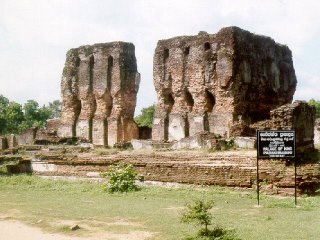Vijaya B.C. 543 Tambapanni
Interregnum 505
Panduvasudeva 504 Vijitapura
Abhaya 474
Interregnum 454
Pandukabhaya 437 Anuradhapura
Mutasiva 367
Devanampiya Tissa 307 B.C. 247
Uttiya 267
Mahasiva 257
Suratissa 247
Sena and Guttika 237
Asela 215
Elara 205
Duttha Gamani 161
Saddha Tissa 137
Thulanthana 119
Lanja Tissa 119
Khallata Naga 109
Vatta Gamani 104
Five Tamils 103
Vatta Gamani (restored) 88
Mahachuli Maha Tissa 76
Chore Naga 62
Tissa 50
Siva 47
Vatuka 47
Daru Bhatika Tissa 47
Niliya 47
Anula 47
Kutakanna Tissa 42
Bhatikabhaya 20
Mahadathika Maha Naga A.D. 9
Amanda Gamani 21
Kanirajanu Tissa 30
Chulabhaya 33
Sivali 35
Interregnum of three years
Ila Naga 38
Chandamukha Siva 44
Yassalalaka Tissa 52
Subharaja 60
Vasabha 66
Vankanasika Tissa 110
Gaja Bahu I 113
Mahalla Naga 135
Bhatika Tissa 141
Kanittha Tissa 165
Khujja Naga 193
Kuncha Naga 195
Siri Naga I 196
Voharika Tissa 215
Abhaya Naga 237
Siri Naga II 245
Vijaya Kumara 247
Sangha Tissa 248
Sanghabodhi {Siri Sangabo) 252
Gothakabhaya 254
Jettha Tissa I 267
Mahasena 277
Siri Meghavanna 304 c. 340
Jettha Tissa II 332
Buddhadasa 341
Upatissa 370
Mahanama 412 c. 428
Sotthi Sona 434
Chhattagahaka 434
Mitta Sena 435
Six Tamils 436
Dhatusena 463
Kassapa I 479 c. 527 Sigiriya.
Moggallana I 497 Anuradhapura.
Kumara Dhatusena 515
Kittisena 524
Siva 524
Upatissa II 525
Amba Samanera Silakala 526
Dathappabhuti 539
Moggallana II 540
Kittisiri Meghavanna 560
Maha Naga 561
Aggabodhi I 564
Aggabodhi II 598 c. 609
Sangha Tissa 608
Dalla Moggallana 608
Silameghavanna 614
Aggabodhi III 623
Jettha Tissa III 623
Aggabodhi III (restored) 624
Dathopatissa I 640
Kassapa II 652
Dappula I 661
Dathopatissa II 664
Aggabodhi IV 673
Datta 689
Unhanagara Hatthadatha 691
Mahavamma 691
Aggabodhi V 726
Kassapa III 732
Mahinda I 738
Aggabodhi VI 741
Aggabodhi VII 781 Polonnaruwa
Mahinda II 787 Anuradhapura
Dappula II (Udaya) 807 ? 790
Mahinda III 812
Aggabodhi VIII 816
Dappula III 827
Aggabodhi IX 843
Sena I 846 ? 819/20 Polonnaruwa
Sena II 866
Udaya I 901
Kassapa IV 912
Kassapa V 929
Dappula IV 939 ? c. 918/9
Dappula V 940
Udaya II 952
Sena III 955
Udaya III 964 ? c. 942/3.
Sena IV 972
Mahinda IV 975
Sena V 991
Mahinda V 1001 Deported c. 1017. Anuradhapura.
Kassapa on Vikrama Bahu 1037
Kitti I 1049
Mahalana Kitti 1049
Vikrama Pandya 1052 Ruhuna.
Jagatipala 1053
Parakrama 1057
Lokissara 1059
Vijaya Bahu I 1056-1111 Polonnaruwa.
Jaya Bahu I 1108-1145/6 Polonnaruwa and Ruhuna.
Vikrama Bahu I 1111-1132 Polonnaruwa.
Gaja Bahu II 1131-1153
Parakrama Bahu I 1153-1186
Vijaya Bahu II 1186-1187
Mahinda VI 1187
Nissanka Malla 1187-1196
Vira Bahu I 1196
Vikrama Bahu II 1196
Codaganga 1196-1197
Lilavati (1) 1197-1200
Sahasa Malla 1200-1202
Kalyanavati 1202-1208
Dharmasoka 1208-1209
Anikanga 1209
Lilavati (2) 1209-1210
Lokissara 1210-1211
Lilavati (3) 1211-1212
Parakrama Pandya 1212-1215
Magha 1215-1236
Vijaya Bahu III c. 1220-1224 Dambadeniya.
Parakrama Bahu II 1234-1269
Vijaya Bahu IV 1267/8-1270
Bhuvanaika Bahu I 1271-1283 Dambadeniya and Yapahu.
Interregnum 1283-1302
Parakrama Bahu III c. 1302-1310 Polonnaruwa.
Bhuvanaika Bahu II ? 1310-1325/6 Kurunagala.
Parakrama Bahu IV 1325/6
Bhuvanaika Bahu III 1325/6
Jaya (Vijaya) Bahu 1325/6
Bhuvanaika Bahu IV 1344/5-1353/4 Gampola
Parakrama Bahu V 1344/5-1359 Dedigama and Gampola
Vikrama Bahu III c. 1357-1374 Gampola
Bhuvanaika Bahu V 1372/3-1404/5 or 1406/7 Gampola.
Vira Bahu II 1391/2-1396/7 Rayigama
Vira Alakesvara (?Vijaya Bahu VI) c. 1397-1409 Rayigama.
Parakrama Bahu Epa ? 1409-1412
Parakrama Bahu VI c. 1412-1467 Kotte.
Jaya Bahu II c. 1467-1472/3
Bhuvanaika Bahu VI 1472/3-1480/1
Parakrama Bahu VII c. 1480/1-1484
Parakrama Bahu VIII c. 1484-1518 7
Parakrama Bahu IX 1509-1528 Kelaniya.
Vijaya Bahu VII 1509-1521 Kotte
Bhuvanaika Bahu VII 1521-1551
Dharmapala 1551-1597
KINGS OF SITAWAKA
Mayadunne 1521-1581
Rajasinha I 1554-1593
Rajasurya 1593-1594
KINGS OF KANDY
Vimala Dharma Surya I 1590-1604
Senarat 1604-1635
Rajasinha II 1629-1687
Vimala Dharma Surya II 1687-1707
Narendra Sinha 1707-1739
Vijaya Rajasinha 1739-1747
Kirtisri 1747-1781
Rajadhirarajasinha 1781-1798
Sri Vikrama Rajasinha 1798-1815



